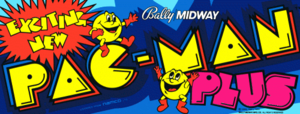The height of Pac-Man's popularity introduced a new wave of arcade bootlegging, where unauthorized copies of Pac-Man were manufactured at a tremendous rate to illegally cash in on the fad. While many bootlegs were carbon copies of the original, some bootlegs (such as Hanglyman and New Puck-X) actually modified the game to introduce some new wrinkles in an effort to make it more interesting and attract expert players who wanted a new challenge.
While Bally Midway proceeded with the manufacturing of Ms. Pac-Man against Namco's wishes, they also sought to stem the flow of bootlegs by producing an officially licensed upgrade to Pac-Man, which they named Pac-Man Plus. As far as Namco was concerned, Super Pac-Man was the true sequel to Pac-Man, and this upgrade was also unauthorized. Nevertheless, Midway proceeded to sell Pac-Man Plus to feed the demand in the U.S. for more Pac-Man products, as Super Pac-Man wasn't performing as well as Midway hoped.
The changes to Pac-Man Plus range from drastic to subtle, and are all detailed in this guide. Since Pac-Man Plus was merely seen as a stop-gap solution to the bootleg arcade problem, and Ms. Pac-Man gained in popularity by the time Plus was released, it wasn't seriously considered for home conversion. No official conversions were made around that time. More recently, homebrew programmers have released conversions of older Atari games in to Pac-Man Plus. It was also included in Jakks Pacific's 2006 Super Pac-Man TV game.
-
Title screen
-
Screenshot



